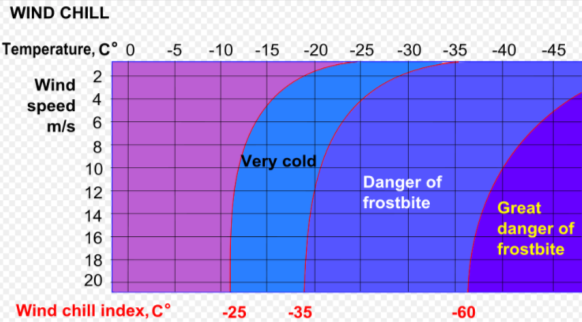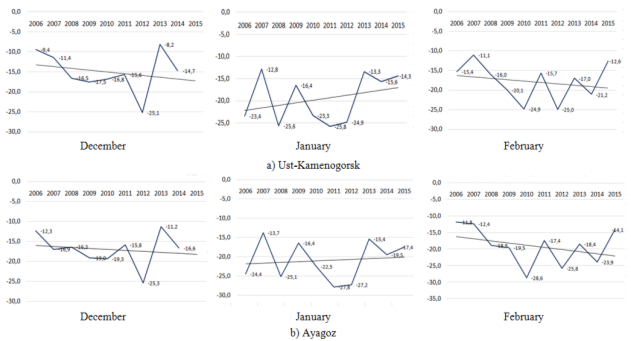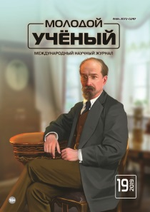The article is about the bioclimatic conditions of the cold period in Ust-Kamenogorsk and Ayagoz for the 2006–2015 years. Because of the fact that the East Kazakhstan region is one of the largest industrial regions of the country, and also for the further development of sanatorium-resort areas, the bioclimatic status of this region is of special interest. The results of the research can be used to create favorable conditions for outdoor activities, to create recreational activities, to use public awareness services.
Keywords: bioclimatic index, meteorological temperature, equivalent temperature, Bodman index, comfort level.
Nowadays, people have developed different kinds of equipment for artificial climate creation inside of the buildings to largerly lose their dependence on weather. However, climatic conditions remain the most important environmental factors that determine human life.
Increasing the quality and numerical impact assessment requirements determine the relevance of the spatial and temporal distribution of bioclimatic indicies in the study area, as the climatic and ecological state of a humans being's permanent residence often defines aspects of their life activity. To determine the level of interaction at the climatic level, it is necessary to determine the bioclimatic conditions for human health. As it is known, that human thermal state is mainly related to microclimate environment. However, it should be noted that the microclimatic parameters do not characterize the quantitative relationship of the thermal state of the body itself. From a meteorological description of the human habitation zone, a person must be able to show the physiological response of the organism to the environment, as well as the quantitative calculation of the human thermal state [1].
Indicator of bioclimate is an indirect indicator characterizing the heat sensitivity of the person in the environment [2].
Currently, many different measurement methods are used to assess human thermal status [3–4]. The main activity of the industry can also be exposed to outdoor temperatures when low temperatures are observed, which can be dangerous for the human body due to cold or even frostbite. [5]. In this regard, an equivalent temperature index was calculated using the Canadian model (WCET) to allow the individual to take account of the complex effects of air temperature, wind speed and humidity [6–7]. The Bodman Index, which also indicates the severe weather conditions, has been identified. The analysis of the spatial distribution of bioclimatic indicators in the studied area allows to demonstrate the obtained information visually.
The WCET indicator for winter was identified for Ust-Kamenogorsk and Ayagoz. The average WCET in Ust-Kamenogorsk ranges from minus 15 ºС to minus 20 ºС. According to the classification of WCET indicators [8], the equivalent temperature corresponds to the «cold» load (Figure 1).

Fig. 1. Wind chill index values and its possible effects
However, the 'cold' levels do not exclude the danger of frostible or harm to the human body. Also, it is important to keep in mind that the frostible level has time dependent.
In Ayagoz, this indicator varies from minus 17 ºС to minus 21 ºС, in terms of «cold» sensitivity to the calculated values. If we look at the minimum values, it is worth noting that the winter season of these regions is tough and adverse to the human body. In East Kazakhstan, the risk of frostible in the winter is much higher, which is evidenced by the minimum temperature. Minimum temperature of air in Ust-Kamenogorsk is minus 42 ºС and minus 45 ºС, in Ayagoz, minus 28 ºС and minus 38 ºС (Table 1).
Table 1
Longterm average WCET and temperature values
|
Cities |
Indicator |
Month |
||
|
December |
January |
February |
||
|
Ust-Kamenogorsk |
WCET,ºС |
-15,0 |
-19,6 |
-17,9 |
|
minimum temperature,ºС |
-42,0 |
-42,1 |
-44,6 |
|
|
mean temperature, ºС |
-12,5 |
-16,1 |
-16,5 |
|
|
Ayagoz |
WCET,ºС |
-17,0 |
-21,0 |
-19,1 |
|
minimum temperature,ºС |
-28,2 |
-38,0 |
-36,6 |
|
|
mean temperature, ºС |
-13,3 |
-16,5 |
-14,8 |
|
According to the results, the trend of WCET values, which was studied for a period of 10 years, has been decreasing in the period of the transitional period, which indicating the adverse weather conditions in the transition period. During the January, the WCET trend has increased, indicating the presence of stable weather without hazards (Figure 2).
Low values of WCET in Ust-Kamenogorsk are estimated at around 2010–2012 years, sharp abnormalities were observed. This can be a sign of much more severe and cold weather. In Ayagoz city minimum values of WCET were observed in 2011–2012 years. In recent years the trend has been decreasing. It can be synoptically evaluated in two ways. First, it can be characterized by the presence of strong winds with intense precipitation coming from northern or ultrapolar entrances, and on the other hand, it can be explained by frosts associated with a strong, stable Siberian anticyclone.

Fig. 2. Long term rate of WCET index
By long term rate of WCET values in the considered area exaggerates climatic severity than climatic warming. In this regard, there are adverse weather conditions in winter. Freezing conditions are increasing, as well as negatively affecting other social situations.
The Bodman weather severity index was determined to assess the comfort level of the cold season in Ust-Kamenogorsk and Ayagoz. This index determines the state of the frostible possibility. The Bodman index is characterized by low temperatures and wind speeds. These values have a special effect on the respiratory tract and the human body.
It is known that the human feel weather temperature lower, when it is strong wind, but we can get information on how rigid it is through these indices. The Bodman index is used only for cold periods. Each bioclimatic indicator has its own scale or classification. Similarly, the Bodman Index has its own scale. Each digital data corresponds to a certain level of comfort. It describes how soft or tough the winter is. In this regard, the Bodman scale is used for quantitative indices (Table 2).
Table 2
Bodman scale
|
Bodman indicator |
Characteristic |
|
1 |
soft winter |
|
1–2 |
weak harsh winter |
|
2–3 |
moderate harsh winter |
|
3–4 |
harsh winter |
|
4–5 |
very harsh winter |
|
5–6 |
hard harsh winter |
|
>6 |
extremely harsh winter |
During the study, the Bodman Index, which has been identified for 10 years, has a bioclimatic value characterizing the severity of the weather in the range of about 2–3 (Table 3). This indicator is dependent on the wind speed, the higher the wind speed, the lower the actual air temperature. Taking into account the observed long-term wind speeds, the Ayagoz station was about 34 m/s, with gusts up to 40 m/s. The average annual wind speed in Ust-Kamenogorsk is 19 m/s, with gusts up to 29 m/s.
Table 3
Average variety of Bodman index
|
Cities |
Months |
||
|
December |
January |
February |
|
|
Ust-Kamenogorsk |
2,4 |
2,5 |
2,5 |
|
Ayagoz |
2,5 |
2,8 |
2,7 |
According to the Bodman scale, the winter load level was moderately rigid. The most cold winter in 10 years provided for this index was 3,8 in Ayaguz in 2012 year. In general, during the period studied in Ust-Kamenogorsk, «harsh winter» was observed in 10 % of the cases, 90 % in «moderate harsh winter» and in 20 % in Ayagoz, «harsh winter» and in 80 % «moderate harsh winter».
According to the results, in winter Ayagoz and Ust-Kamenogorsk corresponds to the «cold» load of winter by the equivalent temperature (Table 4). If this value of the WCET indicator is observed, the person is advised to wear warm clothes, be active in the open air and not to stay outdoors for a long time [9].
Table 4
The comfort characteristics
|
Cities |
WCET |
Сharacteristics |
Bodman index |
Сharacteristics |
|
Ust-Kamenogorsk |
-20,5 |
cold |
2,7 |
moderate harsh winter |
|
Ayagoz |
-20,6 |
cold |
2,7 |
moderate harsh winter |
According to the results, in winter Ayagoz and Ust-Kamenogorsk corresponds to the «cold» load of winter by the equivalent temperature. If this value of the WCET indicator is observed, the person is advised to wear warm clothes, be active in the open air and not to stay outdoors for a long time [9]. In this case there is a normal risk of frostbite. And the Bodman index corresponds to the «moderate harsh winter» load level. According to the Bodman Index, which determines the toughness of the weather, it has been observed that «moderately harsh winter» have been observed and rarely observed «harsh winters». Summarizing the results of the study, it was found out that in the winter months of Ust-Kamenogorsk and Ayagoz there is a significant cold, which has moderate danger for human body. In cold weather, warm clothing is recommended and avoiding adverse weather conditions.
References:
- Sergeyeva G. А. Assessment of bioclimatic conditions based on calculated values of climate comfort indicators (using the example of the Volgograd region) // Russian State Hydrometeorological University. — St. Petersburg, 2007. -25 p.
- Isaev A. A. Ecological climatology. — Moscow: Nauch. world, 2001. -458 p.
- Kobysheva N. V., Stadnik V. V., Klyueva M. V., Pigoltsina G. B., Akenteva E. M., Galyuk L. P., Razova E. N., Semenov Yu.A. Manual on the specialized climatological service of the economy. — St. Petersburg, 2008. -336 p.
- Khairullin K.Sh., Karpenko V. N. Bioclimatic resources of Russia. Specialized climate indicator for assessing the safety of work outdoors in harsh cold conditions // Encyclopedia of Climatic Resources of the Russian Federation. — St. Petersburg: Gidrometeoizdat, 2005. P. 25–46.
- Shipko Yu.V., Shuvakin E. V. Heliogeophysical studies // Military Training and Research Center of the Air Force “Military Academy named after Professor N.Ye. Zhukovsky and Yu.A. Gagarin. — Voronezh, 2014. Vol. 9. P. 161–165.
- Missenard, A. L’homme et le climat. Paris. 1937; 186.
- Shitzer A, de Dear R. Inconsistencies in the «new» wind chill chart at low wind speeds. Journal of Applied Meteorology and Climatology. 2006; 45: 787–790.
- Wind chill. Electronic resource: https://en.wikipedia.org/wiki/Wind_chill
- Environment and climate change Canada.Electronic resource: http://www.ec.gc.ca/meteo-weather/default.asp?lang=n&n=5FBF816A-1#wc6







